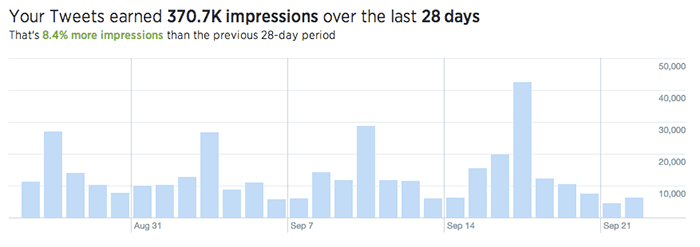Content marketing and social media are two distinct marketing channels that are intrinsically linked to one another and can have a profound impact on your business if used appropriately.
Social media can be considered a form of content marketing, but for the purposes of this article let’s look to content marketing as the content you’re developing to serve your audience and social media as the distribution network that you’re sharing that content on.
Creating content that best meets your audience’s needs across social media requires a succinct strategy and plan of execution in order to drive results for your business.
These channels shouldn’t be handled in a silo, but coordinated as a part of one larger marketing mix for your business along with your email marketing, public relations, pay-per-click advertising, search engine optimization, etc.
Here are the 4 necessary steps to better coordinate your content marketing and social media strategies to drive results for your business.
1. Start Researching and Dive Head First Into Data
Social media provides an unparalleled opportunity to listen to your audience and gather valuable insights about the types of content and topics they would be interested in consuming.
This doesn’t mean you need your own audience to start with on one of these channels quite yet, but instead you can use social media to monitor the behaviors, interests, and patterns of individuals that match your buyer personas.
Analyze what types of content are most shared on different social channels as they relate to your industry and your ideal customer base to help inform the various types of content your business should produce to match the interests of your audience — as well as the topics this content should regularly be covering.
Consider using focus groups or conducting a survey to try and gather insights from the right customer base active on social media. This way, your business has additional data points to analyze when informing the types of content to develop and how to present this information on those channels.

If your business does already have a following on social media, review your analytics on each channel like Twitter, Facebook, YouTube, and others you’re active on to better understand their habits, behavior, and preferences to inform your efforts creating and distributing content for the future.
Also take the time to analyze the activities of visitors on your website who were referred from social media to better understand if coming from those channels influenced their behavior in any way.
This data can help your business understand what types of content perform well on what social channels. For instance, blog posts perform better on Facebook, and visuals do better on Pinterest.
Better coordinating your content with social media starts with analyzing the data available to your organization and conducting extensive research to make up for any lack of data on the habits of your existing or future customer base.
These insights will serve as a foundation for the rest of your marketing strategy, which can help better coordinate your approach to each channel.
2. Set Goals for Your Marketing
The next step is to outline your goals for content marketing as well as social media. It’s critical to establish these goals before proceeding to ensure your organization stays on track with your efforts and that they eventually reap tangible results for your business.
These goals could be to drive more traffic to your website, increase brand visibility, increase engagement with your business, generate more sales, etc.
Once you’ve established the goals for your content and your social media, compare your two lists to see which goals are the same or overlap in some capacity. Identify as many opportunities as possible where the execution of your content directly impacts your social media presence.
By coordinating the goals of your content and social media, it’ll be easier to make smarter decisions and take actions that accomplish a few goals all at once. This coordination of your goals will help your business save time, money, and valuable resources.
3. Establish an Editorial Calendar
Organization is critical to the effective coordination of your content and social media. Once you’ve conducted the right research to inform your content choices and establish your goals, it’s time to map out the consistent content series that will live on each social channel you’d like to be active on or are already active on.
This is where an editorial calendar comes into play, where your marketing can be laid out to understand what audiences you’ll be creating content for and what types of content suit each channel.
Creating a robust editorial calendar doesn’t have to be difficult: Try using one of these free templates from HubSpot, Content Marketing Institute, or Shareaholic (you have to provide your email to gain access to this one).
With an editorial calendar for your business, it’s much easier to understand where your content and social media overlap, which is likely more often than expected.
A good rule of thumb is to start by planning to create a piece of content that’ll live on your Web properties like a white paper or a blog post, then consider which social channel’s audience that content will resonate with the most.
It’s important that a majority of your content live on your own Web properties to help ensure your business receives the full benefits of your efforts including traffic, inbound links, sales, etc.
Continue to keep the audience of certain social networks in mind when creating this content to best suit it to their needs and the unique nuances of that particular social channel.
For example, if you’re creating a resource for your LinkedIn audience, then the tone of the content should be professional, business-focused, and more targeted to the needs of a user’s specific job role over other demographics.
Secondly, when you’re creating content to live on your own Web properties or elsewhere, consider the other formats of content needed to help support it across social media.
If you’ve developed a blog post to share with your audience, plan on your editorial calendar how you’ll share that same blog post on Twitter, Facebook, LinkedIn, Pinterest, and Google+.
This is where you’re able to understand how the same information presented in your original piece of content will live on each of the social channels you’re active on as another smaller piece of micro-content.
This could require planning which visuals from your blog post will be shared on Pinterest, drafting a mini summary of your article to share on Google+, pulling the headline with a compelling quote to share on your Facebook page, and so on.
These actions across social media should all link back to your original blog post and help drive more engagement, traffic, and actions from it being published on your website and across relevant social channels.

For example, Sephora published a blog post on its website about New York Fashion Week and then proceeded to share it on Facebook, Twitter, and elsewhere on social media to alert their audience of the post.
This approach is also known as repurposing content. The time, effort, and information your team already invested in creating the original piece of content should be utilized elsewhere across your network in different formats to make the most of your resources.
Use an editorial calendar to help properly manage the distribution of your content across social media and ensure that each piece of content is properly optimized for each marketing channel appropriately.
4. Practice Consistency Across Channels
Repurposing your content into a few different forms across your active social networks is a powerful way to reach your audience at scale.
What’s important about this approach is that it is executed consistently wherever your audience chooses to interact with your business.
The themes addressed in the information you’re providing in your content on your own website, across social media, email marketing, and elsewhere should present one singular message in order to prevent confusing your audience, while increasing the visibility of your content amid the noise.
As discussed earlier, analyzing the data that your business has available will inform your company’s decision on what types of content to produce and what topics to cover.
At the end of the day, your audience ultimately defines the direction of your content marketing strategy, which is why it’s essential to continue to provide relevant content that they are reacting to according to your data to ensure you’re keeping their attention.
The long-term coordination of your content and your social media depends on providing information that’s relevant to your audience, consistent to help prevent any confusion, and always related to your company’s offerings in some capacity.
How does your organization best use your resources to succeed with content marketing and social media? What’s the biggest hurdle for effectively coordinating your marketing?
Sound off in the comments below.
Not Sure How to Implement These 4 Steps?
If you need help putting together your content strategy – or you just don’t know where to start, we can help. Digital Current has over a decade of experience helping businesses construct content strategies that produce real results.
Reserve Your 1-On-1 Content Strategy Consultation Now
Images courtesy of Death to Stock Photo and Shareaholic.




